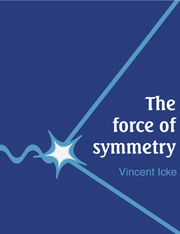Book contents
- Frontmatter
- Contents
- Preface
- Introduction
- 1 A matter of force
- 2 Stalking the wild rainbow
- 3 Light
- 4 Maybe I'm Heisenberg
- 5 Catch a falling quantum
- 6 Quantum beanbags
- 7 Symmetries
- 8 Quantum relativity: nothing is relative
- 9 Life, the Universe and everything
- 10 The physics of a tablecloth
- 11 Colour me red, green and blue
- 12 Smashing symmetry
- 13 How much is infinity minus infinity?
- 14 Excelsior! The ascent to SU(∞)
- A modest reading proposal
- References
- Glossary
- Index
13 - How much is infinity minus infinity?
Published online by Cambridge University Press: 05 August 2012
- Frontmatter
- Contents
- Preface
- Introduction
- 1 A matter of force
- 2 Stalking the wild rainbow
- 3 Light
- 4 Maybe I'm Heisenberg
- 5 Catch a falling quantum
- 6 Quantum beanbags
- 7 Symmetries
- 8 Quantum relativity: nothing is relative
- 9 Life, the Universe and everything
- 10 The physics of a tablecloth
- 11 Colour me red, green and blue
- 12 Smashing symmetry
- 13 How much is infinity minus infinity?
- 14 Excelsior! The ascent to SU(∞)
- A modest reading proposal
- References
- Glossary
- Index
Summary
Dressing up
Now that I have introduced the symmetries that rule the vacuum, it is time to compare the behaviour of the various forces which these symmetries generate. When we do this, we must realize that such a comparison means that we will have to consider the behaviour of the forces at very small distances as well as at very large ones. Because of the need to include all length scales, we are obliged to treat quantum interactions in a global way. We have seen in the discussion of Feynman diagrams that splitting a relativistic quantum phenomenon into pieces that are too small makes the bits individually unmanageable. Globally, however, they can often be handled.
We must think of the behaviour of a force not as due to one Feynman diagram, but as due to the collective effect of all possible diagrams in which gauge twists of a certain symmetry are involved. The individual diagrams are indistinguishable: only the in- and outgoing states of the particles are fixed. What happens in between is indeterminate. Thus, we get interference between the various alternatives. This interference, as always, can be destructive or constructive. As we will see presently, this has a profound influence on the way in which a force depends on the distance over which it acts.
- Type
- Chapter
- Information
- The Force of Symmetry , pp. 249 - 268Publisher: Cambridge University PressPrint publication year: 1995



